Network monitoring tools are software applications or hardware appliances that provide administrators with real-time and historical traffic visibility across on-premises, cloud, virtual, and edge networks. They track the behavior, traffic, and health of standard network components like endpoints, firewalls, routers, switches, and servers. We’ve evaluated the top network monitoring tools available on the market to help you choose the most suitable solution for your business.
Here are the seven best network monitoring tools:
- ManageEngine: Best overall network monitoring tool
- Datadog: Best for data privacy and legal compliance
- Dynatrace: Best for advanced monitoring features
- SolarWinds: Best for customer and resource support
- Zabbix: Best open-source network monitoring solution
- LogicMonitor: Best for core monitoring capabilities
- Auvik: Best for network control and troubleshooting
Top 7 Network Monitoring Tools Comparison
We examined the following tools’ capabilities for key network monitoring features like network device discovery, automated alerts, and data retention. Also provided below are the availability and duration of free trials and the pricing information for each tool.
| Network Device Discovery | Automated Alerts | Default Data Retention | Free Trial | Subscription Price | |
|---|---|---|---|---|---|
| ManageEngine | ✔️ | ✔️ | 7 days | 30 days | $21+/month/10 devices |
| Datadog | ✔️ | ✔️ | 30 days | 14 days | $5+/month/host |
| Dynatrace | ✔️ | ✔️ | 35 days | 15 days | $58+/month/8 GiB host |
| SolarWinds | ✔️ | ✔️ | 1 year | 30 days | $154+/month |
| Zabbix | ✔️ | ✔️ | 6 months | Open source | Free |
| LogicMonitor | ✔️ | ✔️ | 2 years | 14 days | Contact sales for info |
| Auvik | ✔️ | ✔️ | 1 year | 14 days | Contact sales for info |
Note: Subscriptions are billed annually, except for Dynatrace’s per-usage billing.

ManageEngine
Best Overall Network Monitoring Tool
Overall Rating: 4.4/5
- Core features: 4.3/5
- Pricing and transparency: 4.5/5
- Advanced features: 4.2/5
- Ease of use and admin: 4.8/5
- Customer support: 4/5
- Regulatory compliance: 5/5
ManageEngine is our leading network monitoring solution that includes comprehensive functionality for devices, applications, and bandwidth usage. It provides more than 110 products and tools for app performance, servers, and networks, including OpManager Plus and Site24x7. OpManager Plus analyzes traffic, monitors network performance, and manages firewalls, IP addresses, and switch ports. Site24x7 offers APM and website monitoring.
ManageEngine meets a range of regulatory standards, but if you prioritize compliance and data privacy, Datadog may be a better option as it offers more detailed information on both.
Pros & Cons
| Pros | Cons |
|---|---|
| Easy use and administration | Less scope of system integrations |
| Extensive compliance to regulatory standards | Default data retention is only for 7 days |
| Offers a free edition that supports 3 devices | Uses a lot of disk space to store network data |
Pricing
- Free edition: OpManager monitors up to 3 devices
- Standard edition: $21+ per month for 10 devices, billed annually
- Contact for quote: Custom pricing available
- Free trial: 30 days
- Free demo: Contact to schedule
Key Features
- Metrics and health tracking: Uses 2,000+ built-in network performance monitors.
- Multi-level thresholds: Customizes network performance expectations and alerts.
- In-depth monitoring: Covers latency, RTT, packet loss, and hop-by-hop performance.
- Custom admin dashboard: Utilizes 200+ performance widgets for admin use.
- Versatility: Supports virtual (VMware, Xen, Nutanix) and physical servers.
If you’d like to know more about ManageEngine’s key IT security solutions, read through our ManageEngine product review.
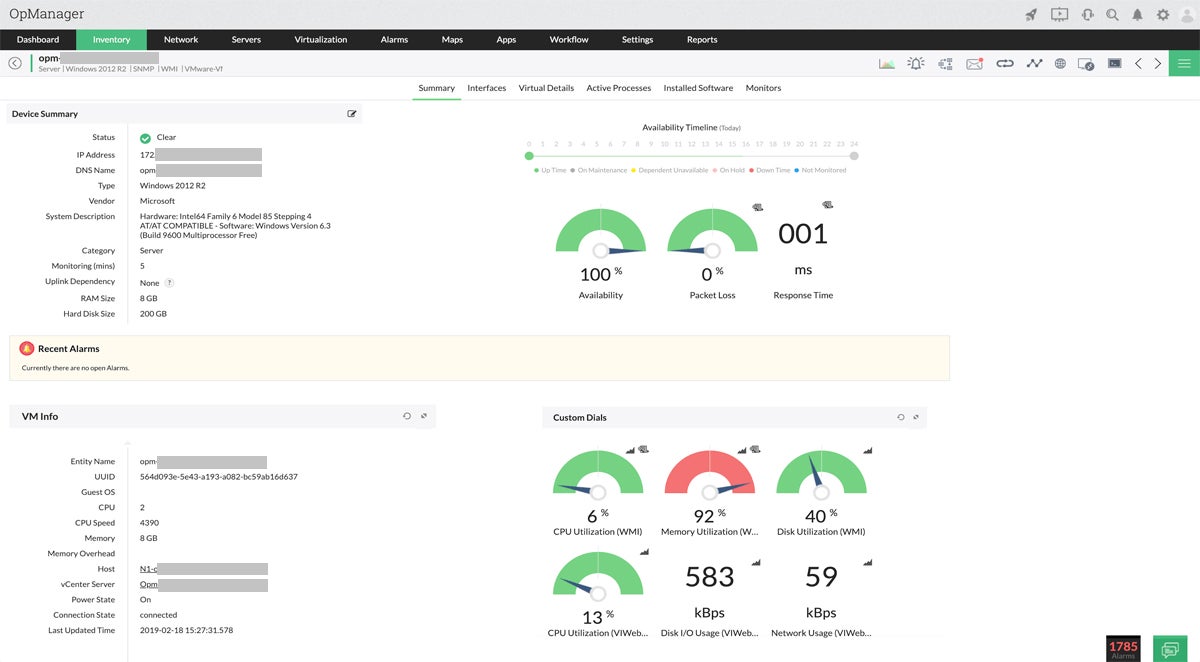
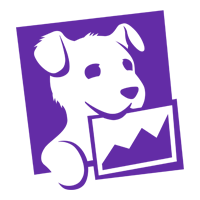
Datadog
Best for Data Privacy & Legal Compliance
Overall Rating: 4/5
- Core features: 4.3/5
- Pricing and transparency: 3.3/5
- Advanced features: 3.8/5
- Ease of use and admin: 4.3/5
- Customer support: 4/5
- Regulatory compliance: 5/5
Datadog excels at data privacy and legal compliance, thanks to its extensive network security features and regulatory adherence. It uses solid encryption, role-based access, and thorough audit trails, making it suitable for highly regulated industries. Datadog also specializes in service-oriented architecture optimization, which includes monitoring user journeys, exploring service relationships, and filtering data by container, team, or device.
Datadog offers several add-ons to enhance network monitoring capabilities. Dynatrace, on the other hand, is a network monitoring tool that includes advanced features by default.
Pros & Cons
| Pros | Cons |
|---|---|
| Easy to use and implement | Needs to extend app language support |
| Interactive dashboard | Fairly new so documentation has to be improved |
| High level customization | Users report third-party integration issues |
Pricing
- Starting price: $5+ per host per month, billed annually
- On-demand price: $7.20+
- Contact for quote: Custom pricing available
- Free trial: 14 days
- Free demo: Contact to schedule
Key Features
- Visibility: Includes on-premises, IoT, digital experience, cloud, hybrid networks.
- Network and traffic: Troubleshoots network issues and identifies high traffic teams.
- Network traffic visuals: Visualizes traffic across data centers, containers, and apps.
- Integration metrics: Determines issues lying with a cloud service provider.
- System-wide DNS: Provides system-wide DNS performance and health tracking.


Dynatrace
Best for Advanced Monitoring Features
Overall Rating: 3.9/5
- Core features: 4.4/5
- Pricing and transparency: 2.7/5
- Advanced features: 4.5/5
- Ease of use and admin: 4.3/5
- Customer support: 3.3/5
- Regulatory compliance: 4/5
Dynatrace is a full-stack app performance monitoring and digital experience platform designed for modern hybrid environments. Admins can view infrastructure monitoring features such as entity relationships, behavior, logs, metrics, and vulnerability profiles. Built-in capabilities include KPI optimization, user experience, process automation, and DevSecOps cooperation. It also has IoT sensors, multiple device compatibility, SNMP monitoring, and compliance management.
Dynatrace only provides customer support during business hours, but if you’re looking for 24/7 client support services and extensive tech resources, check out SolarWinds.
Pros & Cons
| Pros | Cons |
|---|---|
| Strong monitoring capabilities | Needs login account to access live chat |
| Per usage billing | Lengthy waiting period for customer support |
| Extensive third-party resources | Price can be costly for large-scale usage |
Pricing
- Full stack monitoring: $0.08 per hour for 8 GiB host
- Contact for quote: Custom pricing available
- Free trial: 15 days
- Free demo: Contact to schedule
Key Features
- Change tracking: Monitors new machines and network devices automatically.
- Process connections: Tracks inbound and outbound connections via network interface.
- Root cause analysis: Determines the impact on customer experience and remediates.
- Capacity planning: Identifies resource-intensive processes at host and process level.
- Health metrics: Provides info for RAM, CPU, disk, and network in a single dashboard.
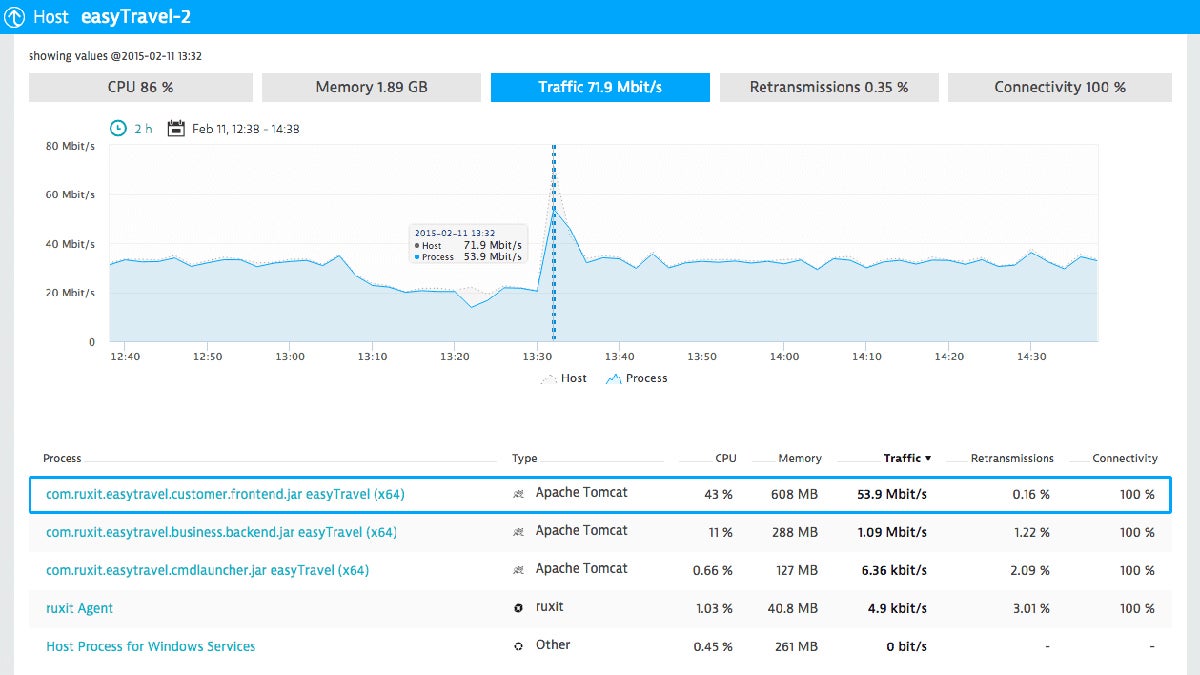

SolarWinds
Best for Customer & Resource Support
Overall Rating: 3.9/5
- Core features: 4.8/5
- Pricing and transparency: 2.6/5
- Advanced features: 4/5
- Ease of use and admin: 4.3/5
- Customer support: 4.7
- Regulatory compliance: 3/5
SolarWinds delivers enterprise monitoring and management tools for networks, systems, databases, services, applications, and security to 99.6% of Fortune 500 companies. It offers a wide range of tool options as standalone products or bundles, including configuration management, device tracking, topology mapping, and log analysis. SolarWinds provides highly-rated user support, extensive resources, training, and an active user community.
SolarWinds might be costly for small businesses. You may want to consider Zabbix’s free and open-source as an alternative for network monitoring tools.
Pros & Cons
| Pros | Cons |
|---|---|
| Service delivery monitoring and diagnostics | High subscription cost |
| Easy implementation and 24/7 support | Less scope of system integrations |
| Large-scale environments configuration | Compliance needs improvement |
Pricing
- Basic subscription: $155+ per month, billed annually
- Contact for quote: Custom pricing available
- Free trial: 30 days
- Free demo: Contact to schedule
Key Features
- Performance monitoring: Tracks applications, VMware hosts, and servers.
- Log investigation: Identifies the root cause of issues via log and events data collection.
- Automated monitoring: Enhances traffic and change management for hybrid networks.
- VoIP monitoring: Provides WAN performance insights and QoS metrics.
- User device tracking: Monitors devices, IP address management, and trend analysis.
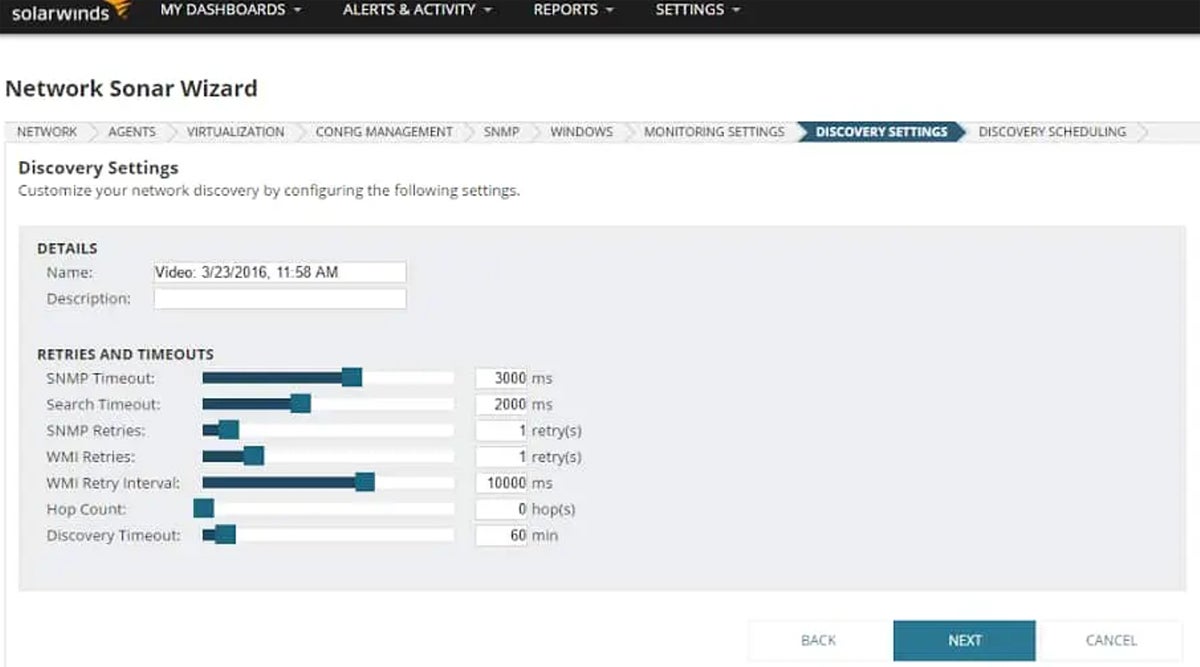

Zabbix
Best Open-Source Network Monitoring Solution
Overall Rating: 3.8/5
- Core features: 4.2/5
- Pricing and transparency: 5/5
- Advanced features: 2.8/5
- Ease of use and admin: 4.3/5
- Customer support: 3.7/5
- Regulatory compliance: 2/5
Zabbix offers organizations an inexpensive yet powerful solution for monitoring network infrastructure and applications. It was first released to the open-source community in 2004, then later expanded the solution’s capabilities to the enterprise audience. While it offers a lesser number of advanced features, it still provides a comprehensive set of fundamental features for deployment, integration, service monitoring, and data visualization.
Zabbix provides a six-month data retention period. However, for extended data retention of up to two years, consider LogicMonitor.
Pros & Cons
| Pros | Cons |
|---|---|
| Active peer user community | Compliance needs improvement |
| Strong monitoring for networks and servers | Needs more advanced monitoring features |
| Easy use and customization | Customer support could be better |
Pricing
- Zabbix open source software: $0, free to redistribute under GNU GPL terms
- Contact for quote: Ask about Zabbix for MSPs
- Free demo: Contact to schedule
Key Features
- Root cause and SLA monitoring: Determines business-level impact for continuity.
- Metrics: Analyzes cloud services, log files, databases, apps, and IoT sensors.
- Data protection: Defines metrics for allow and deny lists for sensitive data access.
- Threat detection: Uses machine learning, trend prediction, and smart thresholds.
- Component discovery: Installs in minutes for on-premises or cloud networks.
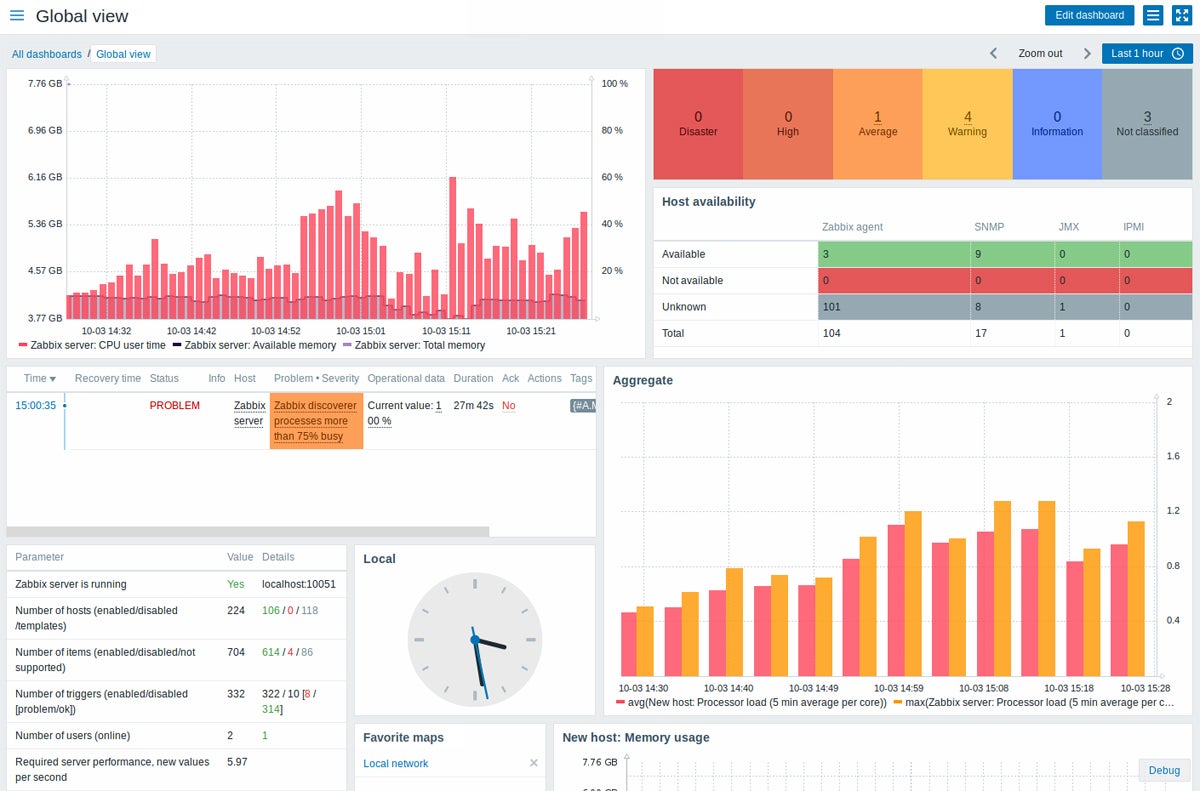

LogicMonitor
Best for Core Monitoring Capabilities
Overall Rating: 3.7/5
- Core features: 5/5
- Pricing and transparency: 1.5/5
- Advanced features: 4.2/5
- Ease of use and admin: 4.3/5
- Customer support: 4.4/5
- Regulatory compliance: 3/5
LogicMonitor is a cloud-based infrastructure monitoring platform for apps, databases, containers, servers, storage, context-aware logs, and other features. It stands out for its complete core network monitoring services, such as automated device discovery, ML-based alerts, and hardware health monitoring, network mapping, integrations, and traffic analysis. The Pro Core package and Enterprise plan are designed to accommodate different types of infrastructure.
Although LogicMonitor is typically considered user-friendly for network monitoring, Auvik receives higher ratings for ease of use and setup from users.
Pros & Cons
| Pros | Cons |
|---|---|
| Flexible customization with extensive features | Lacks transparent pricing |
| 2,000+ integrations | Platform demo needs improvement |
| Component and service delivery monitoring | Free trial is limited to only 14 days |
Pricing
- Contact for quote: Pro Core package, Enterprise plan, and custom plans available
- Free trial: 14 days
- Free demo: Contact to schedule
Key Features
- Integrations: Access 2,000+ preconfigured integrations like Azure, Oracle, and more.
- Access: Uses role-based access control and user authentication like 2FA and SAML.
- Sandboxing: Tests custom modules before deploying to environments.
- Synthetic transaction coverage: Performs ping, multi-step, and service tests.
- Compliance: Adheres to SOC2 Type 2 standards and ISO/IEC 27001:2013.

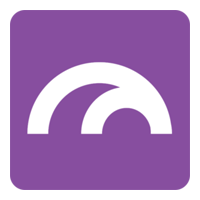
Auvik
Best for Network Control & Troubleshooting
Overall Rating: 3.6/5
- Core features: 4.6/5
- Pricing and transparency: 1.5/5
- Advanced features: 4.3/5
- Ease of use and admin: 4.5/5
- Customer support: 3.2/5
- Regulatory compliance: 3/5
Auvik provides cloud-based network management tools, including IT asset management, traffic analysis, and performance monitoring. The Essentials plan focuses on monitoring and alerting. The Performance plan includes additional features such as forensic traffic statistics, ML-powered application visibility, and network flow analytics. By providing deep visibility, intuitive tools, and efficient management, Auvik stands out as a top choice for network control and troubleshooting.
Despite Auvik’s excellent network control and troubleshooting tools, ManageEngine outperforms it with a more comprehensive set of core functions for network monitoring and compliance.
Pros & Cons
| Pros | Cons |
|---|---|
| Easy setup with standard APIs | Needs a compliance management tool for users |
| Component monitoring capabilities | Lacks transparent pricing |
| Intelligent network traffic analysis | Users report some difficulties in device support |
Pricing
- Contact for quote: Essentials plan, Performance plan, and custom pricing available
- Free trial: 14 days
- Free demo: Contact to schedule
Key Features
- Data encryption: Uses AES-256 for data at rest and TLS v1.2 for data in transit.
- Accessibility: Offers tools for remote work, global dashboards, and geo IP tracking.
- 24/7 support: Provides active DevOps team for tech support and threat remediation.
- Logical secure access: Includes role-based access control, 2FA, and SSO.
- Automated configuration backup and recovery: Enhances policies and controls.

Top 5 Features of Network Monitoring Tools
Network monitoring tools provide a broad set of functions necessary for managing modern network systems. The tools’ key features include discovery and monitoring of network devices, automated alerts and reporting, and hybrid, on-premises, and cloud coverage. It also offers compliance management and health monitoring for network longevity.
Network Device Discovery
Network device discovery observes and maps all devices on a network. This feature gives complete visibility, facilitating easy management and troubleshooting. It simplifies inventory management, improves security by detecting illegal devices, and enables preemptive monitoring to anticipate possible network issues before they even develop to ensure optimal network performance and dependability.
Automated Alerts & Reporting
Network monitoring systems use automated alerts and reporting features to notify admins of network anomalies, allowing prompt intervention to avoid downtime or performance decline. It also provides significant insights into network health and performance trends for more informed decision-making and compliance adherence. It makes network management easier, increases productivity, and improves overall network stability and security.
Hybrid, On-Premise & Cloud Coverage
This feature grants complete visibility across many infrastructures, including on-premise servers, cloud services, and hybrid environments. It also allows for seamless management, monitoring, and troubleshooting regardless of deployment model, which promotes agility, scalability, and resilience. It’s crucial for businesses to navigate complicated IT ecosystems, optimize performance, and ensure consistent service delivery across all settings.
Compliance Management
Compliance management ensures conformity to regulatory standards and organizational regulations. These tools assist in identifying non-compliant behavior, implementing relevant controls, and producing audit-ready reports by continuously monitoring network activities and configurations. It reduces regulatory risk and improves data security. Effective compliance management is vital for operational integrity and consumer trust.
Health Monitoring
Users benefit from the solution’s capacity to provide real-time visibility into the overall health of network infrastructure. Health monitoring detects possible issues early by continuously checking critical performance parameters such as bandwidth use, latency, and device status. This strategy leads to faster resolution, reduces downtime, and improves network performance, thus boosting productivity and customer satisfaction.
How We Evaluated the Best Network Monitoring Tools
We used a structured scoring methodology to assess various network monitoring tools, which consisted of six major criteria, each with weighted subcriteria. We used these ratings to assign each product a five-point overall score. We then determined the seven highest-scoring network monitoring tools, and their scores helped us identify the appropriate use cases for each product.
Evaluation Criteria
To objectively assess the top network monitoring tools, we measured core features, pricing, advanced features, ease of use and administration, customer support, and regulatory compliance.
- Core features (25%): This category covers key functionalities of network monitoring tools, including automated device discovery, ML-based alerts, hardware health monitoring, hybrid, on-premise, and cloud coverage, network mapping and more.
- Criterion winner: LogicMonitor
- Pricing and transparency (20%): We considered factors like free trial availability, price accessibility and transparency in vendor websites, flexibility in pricing models, availability of a free plan or a perpetual free tier, and pricing per host per month.
- Criterion winner: Zabbix
- Advanced features (20%): We assessed advanced features of network monitoring tools, including IoT device monitoring/sensors, vulnerability management, infrastructure, APM, and logs support. We also looked into other advanced features available.
- Criterion winner: Dynatrace
- Ease of use and admin (15%): This category examines ease of use and administration aspects of network monitoring tools, encompassing features such as SSO authentication, customizable reports, and user-rated ease of use on G2 and Capterra.
- Criterion winner: ManageEngine
- Customer support (10%): We evaluated customer support services, including the availability of live chat, phone, and email support channels, availability of documentation, demos, and training resources, and user-rated quality of support on G2 and Capterra.
- Criterion winner: SolarWinds
- Regulatory compliance (10%): We looked into certifications like ISO 27001 and 9001, HIPAA compliance, and PCI DSS compliance. We also evaluated GDPR compliance for EU data privacy standards, as well as SOC 2 compliance for data security.
- Criterion winner: Multiple winners
Frequently Asked Questions (FAQs)
What’s the Difference Between Network vs. Application & Database Monitoring?
Database monitoring, like SQL server monitoring, has long been used to track data flow in enterprise systems. In contrast, application performance monitoring (APM) is the latest solution to address how users interact with applications and the increasingly complex application ecosystem. Together, monitoring solutions for databases, applications, networks, and specific IT systems complement and enhance visibility across an enterprise environment.
What Is Network Detection & Response (NDR)?
NDR goes beyond traditional EDR in monitoring, detecting, and responding to threats to internal networks. NDR solutions typically offer administrators visibility and control for insider threat detection, user behavioral analysis, and more.
Bottom Line: Optimize Operations with Network Monitoring Tools
Network monitoring tools refine performance control, fault tolerance, visibility, and monitoring for administrators. With the rise of enterprise networks and the addition of virtual, cloud, and edge networks, monitoring tools play a significant role in network management. The right tool should be able to balance business performance and your cybersecurity needs. Take advantage of the free trials and check out the free demos to see if your chosen solution suits your business needs.
Network monitoring, while crucial, is just one aspect of ensuring comprehensive network security. Combine it with network firewalls to enhance threat detection, incident response, and overall network protection.




